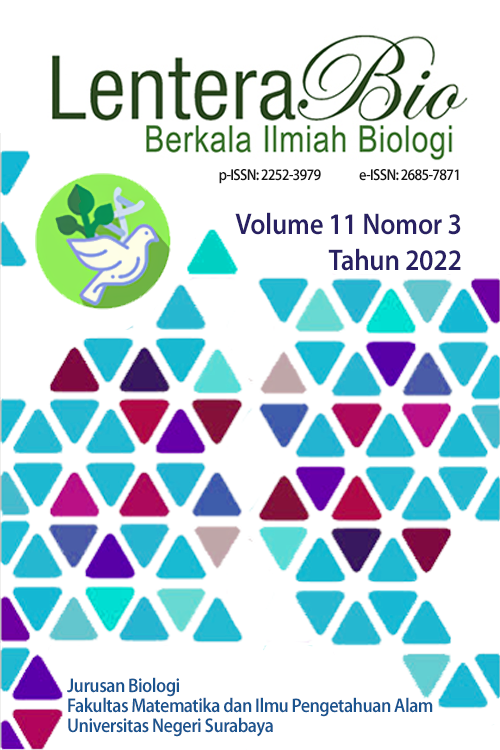Utilization of Eco-enzymes from Citrus Peels and Pineapple Peels Waste as Detergent LAS Remediation Agent
DOI:
https://doi.org/10.26740/lenterabio.v11n3.p503-513Keywords:
degradation, eco-friendly, water pollutionAbstract
Linear Alkylbenzena Sulfonate (LAS) is one of the largest pollutants in the water. This study was aimed to determine: (1) the characteristics of eco-enzymes from citrus peels and pineapple peels waste. (2) the effect of using eco-enzymes at various consentration in decreasing LAS levels and water quality. (3) the optimal concetration of eco-enzymes in decreasing LAS levels and water quality. This study was an experimental using Randomized Completely Design with one treatment factor, namely the concentration of eco-enzymes at 0%, 5%, and 10% for 5 days. The study was conducted at the Ecology Laboratory, Biology, FMIPA Unesa. There are two stages of study, namely, the stage of making ecoenzymes with the parameters measured in the form of pH, temperature, and TDS. The implementation phase with the measured parameters in the form of LAS levels and water quality (DO, BOD, pH, temperature, and TDS). The first stage of data analysis technique was carried out in a quantitative descriptive manner, while the second stage included the LAS level parameter which was carried out statistically using one-way ANOVA followed by Duncan's test. Then the result refers to PERGUB JATIM No. 72 of 2013 and water quality parameters using quantitative descriptive. The results of the study showed: (1) the characteristics of the ecoenzyme had a mean pH (3.69), temperature (26.8)?, and TDS of 1308 ppm. (2) various concentrations of ecoenzymes affect the decrease in LAS levels and water quality. LAS levels from high to low were 0% (8.30 ppm), 10% (7.00 ppm), and 5% (5.90 ppm). DO water quality 0% (4.02 ppm), 5% (1.43 ppm), 10% (1 ppm); BOD 0% (1.19 ppm), 5% (0.54 ppm), 10% (0.77 ppm); pH 0% (7.20), 5% (6.11), 10% (5.30); temperature 0% (26.73?), 5% (26.76?), 10% (26.8?); and TDS 0% (0.65 ppm), 5% (242.16 ppm), 10% (409.66). (3) 5% concentration is more optimal in reducing LAS levels, but still above the specified quality standard, which is 3 ppm.
References
Gubernur Jawa Timur, 2013. Baku Mutu Air Limbah Bagi Industri Dan/Atau Kegiatan Usaha Lainnya. Peraturan Gubernur Jawa Timur No.72
Rochman, F., Hamami, H. and Sapuan., 2016. Pembuatan IPAL Limbah Deterjen Metode Elektrflotasi Skala Pilot. Journal Kimia Riset, 1(1), pp.58-64.
Fitrihidajati, H., Kustiyaningsih, E. and Rachmadiarti, F., 2020. The Ability of Sagittaria lancifolia as Phytoremediator on Detergent Solution. Journal of Physics: Conference Series, 1569(4).
Hemalatha, M. and Visantini, P., 2020. Potential use of eco-enzyme for the treatment of metal based effluent. IOP Conference Series: Materials Science and Engineering, 716(1).
Hendra, H., Barlian, E., Razak, A. and Sanjaya, H., 2016. Photo-Degradation of Surfactant Compounds Using Uv Rays With Addition of Tio2 Catalysts in Laundry Waste. Sainstek : Jurnal Sains dan Teknologi, 7(1), p.59.
Juwita, R., 2012. Studi Produksi Alkohol Dari Tetes Tebu (Saccharum officinarum L) Selama Proses Fermentasi. Fakultas Teknologi Pertanian, p.8.
Kamiswari, K., Hidayat, M, Thamrin. and Rahayu, Y, S., 2013. Pengaruh Pemberian Detergen Terhadap Mortalitas Ikan Platy sp. LenteraBio 2(1), pp.141.
Puspitasari, R.L., Elfidasari, D., Aulunia, R. and Ariani, F., 2017. Studi Kualitas Air Sungai Ciliwung Berdasarkan Bakteri Indikator Pencemaran Pasca Kegiatan Bersih Ciliwung 2015. Jurnal Al-Azhar Indonesia Seri SainsdDan Teknologi, 3(3), p.156.
Rani, A., Negi, S., Hussain, A. and Kumar, S., 2020. Treatment of urban municipal landfill leachate utilizing garbage enzyme. Bioresource Technology, [online] 297, p.122437. Available at: <https://doi.org/10.1016/j.biortech.2019.122437>.
Rochyani, N., Utpalasari, R.L. and Dahliana, I., 2020. Analisis Hasil Konversi Eco Enzyme Menggunakan Nenas (Ananas Comosus ) dan Pepaya (Carica papaya L.). Jurnal Redoks, 5(2), p.135.
Wimbaningrum, R., Arianti, I. and Sulistiyowati, H., 2020. Efektivitas Tanaman Lembang (Typha angustifolia L.) di Lahan Basah Buatan dalam Penurunan Kadar TSS, BOD dan Fosfat pada Air Limbah Industri Laundry. Berkala Sainstek, 8(1), p.25.
Downloads
Published
How to Cite
Issue
Section
License
Copyright (c) 2022 LenteraBio : Berkala Ilmiah Biologi

This work is licensed under a Creative Commons Attribution-NonCommercial 4.0 International License.
Hak Cipta (c) LenteraBio: Berkala Ilmiah Biologi
Karya ini dilisensikan di bawah Lisensi Internasional Creative Commons Attribution-NonCommercial 4.0.
Pemberitahuan Hak Cipta.
Hak cipta dari artikel yang diterima untuk diterbitkan akan diberikan kepada jurnal sebagai penerbit jurnal. Hak cipta yang dimaksud meliputi hak untuk menerbitkan artikel dalam berbagai bentuk (termasuk cetak ulang). Jurnal mempertahankan hak penerbitan atas artikel yang diterbitkan.
 Abstract views: 5349
,
Abstract views: 5349
, PDF Downloads: 14626
PDF Downloads: 14626











